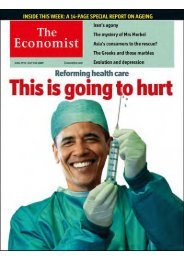Untitled - the ultimate blog
Untitled - the ultimate blog
Untitled - the ultimate blog
You also want an ePaper? Increase the reach of your titles
YUMPU automatically turns print PDFs into web optimized ePapers that Google loves.
Of <strong>the</strong> three firms, AIG represents <strong>the</strong>ir best hope, even though its<br />
credit spreads are still at levels that suggest a real risk of default.<br />
The government fired a blunderbuss of money at it, with six<br />
different categories of intervention (see table). Safest are probably<br />
<strong>the</strong> direct loans from <strong>the</strong> Federal Reserve, <strong>the</strong> commercial paper<br />
that <strong>the</strong> Fed has guaranteed and <strong>the</strong> loans that it is likely to make<br />
that are secured by life-insurance policies. These instruments are<br />
fairly high up <strong>the</strong> pecking order if <strong>the</strong> firm goes bust. The $25<br />
billion preferred-equity stake that <strong>the</strong> Fed owns in two of AIG’s<br />
insurance subsidiaries is also pretty safe: <strong>the</strong>y may be worth as<br />
much as double that sum.<br />
The danger to taxpayers comes in two forms. First, <strong>the</strong> Fed has<br />
lent $44 billion to two special-purpose vehicles, into which many of<br />
AIG’s flakiest securities have been dumped, including derivatives<br />
written on structured-credit instruments. At <strong>the</strong> end of March<br />
<strong>the</strong>se vehicles were $5.4 billion in <strong>the</strong> red: unless prices recover<br />
taxpayers will <strong>ultimate</strong>ly take <strong>the</strong> hit. Second, <strong>the</strong> Treasury has<br />
$43 billion of preferred shares in AIG itself. So far <strong>the</strong> firm’s core<br />
book value (<strong>the</strong> value of its assets) is about equal to that,<br />
suggesting that <strong>the</strong> investment is covered.<br />
The Fed has around 25 full-time staff sitting in AIG now, so its accounts should be more reliable. But even<br />
though AIG made a small profit in <strong>the</strong> second quarter, more losses are possible. It still has a giant<br />
portfolio of credit-default swaps that European banks use to game capital rules. These have not lost<br />
money yet, but remain a black box. And <strong>the</strong> government’s long-term plan to raise cash by spinning off or<br />
selling <strong>the</strong> traditional insurance businesses could crystallise losses. Several AIG assets sold so far have<br />
ended up fetching less than book value.<br />
These risks, though, pale into insignificance compared with Fannie and Freddie. The two have racked up<br />
colossal losses. As Wall Street ate into <strong>the</strong>ir securitisation business, <strong>the</strong>y branched into buying debt<br />
securities worth some $1.6 trillion. Of this about $230 billion turned out to be toxic, with losses of almost<br />
$90 billion at market prices. Future pain will come from <strong>the</strong> traditional guarantee business. The pair have<br />
underwritten $4.8 trillion of mortgages between <strong>the</strong>m and delinquency rates are rising along with<br />
unemployment. Impairments are likely to be only 4-5% of <strong>the</strong> total but that would be more than enough<br />
to sink <strong>the</strong> two agencies.<br />
The government has agreed to fund <strong>the</strong>se losses with equity injections of up to $400 billion. It has<br />
invested $98 billion so far, and Rajiv Setia of Barclays Capital thinks <strong>the</strong> total cumulative capital required<br />
will be $160 billion-200 billion. It could turn out worse. The book value of <strong>the</strong> two firms, using market<br />
prices and excluding <strong>the</strong> existing equity from <strong>the</strong> state as well as tax assets, showed a capital shortfall of<br />
$280 billion at <strong>the</strong> end of June. This sum is a proxy for how much taxpayers will lose unless prices<br />
recover.<br />
Such massive insolvency makes it hard to restructure <strong>the</strong> two agencies. Right now <strong>the</strong>y are staggering on<br />
in “conservatorship”, a form of direct state control. The Treasury is backstopping <strong>the</strong>ir capital and <strong>the</strong> Fed<br />
is helping <strong>the</strong>m refinance <strong>the</strong>ir debts by buying up to $200 billion of <strong>the</strong>ir bonds in <strong>the</strong> open market. Over<br />
time <strong>the</strong>ir holdings of securities will probably be wound down. The guarantee business will be harder to<br />
kill. The government plans to decide on Fannie’s and Freddie’s futures by February, but <strong>the</strong> agencies are<br />
likely to survive under state control or as co-operatives with state guarantees.<br />
This extraordinary resilience reflects <strong>the</strong> widespread political lust in America for subsidising housing.<br />
Anyone who doubts this should look at Ginnie Mae, ano<strong>the</strong>r fully state-owned agency which guarantees<br />
and bundles mortgages, usually of below-average quality, that are insured by <strong>the</strong> government. Fannie and<br />
Freddie are now being conservative about writing new business, but Ginnie is enjoying its own bull<br />
market, issuing guarantees at a furious rate. It is expected to have a trillion dollars outstanding by next<br />
year. “We are seeing a gravitation of <strong>the</strong> subprime universe from Fannie and Freddie to Ginnie”, says Mr<br />
Setia. It will be a miracle if taxpayers get <strong>the</strong>ir money back from Fannie and Freddie. Worse, <strong>the</strong>re is a<br />
chance <strong>the</strong> disaster will be repeated.<br />
Copyright © 2009 The Economist Newspaper and The Economist Group. All rights reserved.<br />
-107-








![[ccebbook.cn]The Economist August 1st 2009 - the ultimate blog](https://img.yumpu.com/28183607/1/190x252/ccebbookcnthe-economist-august-1st-2009-the-ultimate-blog.jpg?quality=85)



![[ccebook.cn]The World in 2010](https://img.yumpu.com/12057568/1/190x249/ccebookcnthe-world-in-2010.jpg?quality=85)
![[ccemagz.com]The Economist October 24th 2009 - the ultimate blog](https://img.yumpu.com/5191885/1/190x252/ccemagzcomthe-economist-october-24th-2009-the-ultimate-blog.jpg?quality=85)